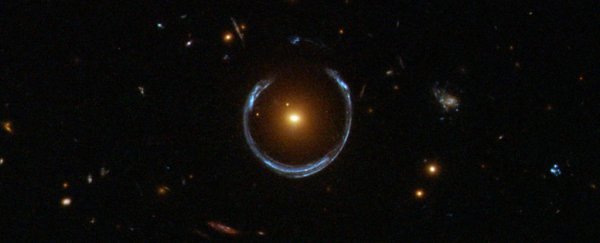The curvature of empty space caused by an entire galaxy has now been pinned down with unprecedented precision, demonstrating Einstein's theory of general relativity still rules on a super-sized scale.
Not that anybody is seriously surprised. But on the off chance the results had failed to meet expectations, they might have provided insight into some of the Universe's biggest mysteries. It can be so boring being right in science.
Astronomers combined data from the European Southern Observatory's Very Large Telescope and NASA's Hubble Space Telescope to examine how light was warped by a nearby galaxy according to Albert Einstein's explanation of gravity.
In principle, the experiment was simply an upscale version of a famous test conducted back in 1915, when Sir Arthur Eddington used the timing of starlight appearing from behind an eclipsed Sun to see how its mass bent their pathway.
The public's mind was blown by the results, effectively turning Albert Einstein into a household name and cementing the concept of general relativity into physics books.
Since then the mathematics behind massive bodies putting a dent in the fabric of space-time has been given a shake over and over again, but only for objects no larger than stars.
There's no reason to assume Einstein's famous idea wouldn't work for bigger things, though.
"General relativity predicts that massive objects deform space-time," says astronomer Thomas Collett from the University of Portsmouth.
"This means that when light passes near another galaxy, the light's path is deflected."
While this lensing effect of whole galaxies has occasionally been put to practical use, nobody had measured the phenomenon with a view to put a precise figure on the absolute curvature they produced.
To do this, the team used galaxy ESO325-G004 thanks to its proximity of a mere 500 million light years away: just down the road in cosmic terms.
The galaxy – called E325 to its friends – eclipsed a second galaxy in such a way the background light was forced to follow the dimpled path created by E325's bulk.
The astronomers then measured the speed of E325's stars to get an estimate on the galaxy's mass, using the relationship between its collective gravity and the stars' inertia.
"We then compared this mass to the strong lensing image separations that we observed with the Hubble Space telescope," says Collett.
The result was bang on what general relativity says it should be, within about 9 percent. Don't get excited about that wiggle room, though - it's within what we'd expect from such a test.
"This is the most precise extrasolar test of general relativity to date, from just one galaxy," says Collett.
For practical purposes, having solid results gives astronomers added confidence that the results gathered through gravitational lensing based on galaxies are as precise as they assume.
But really this is about confirming Einstein was right yet again, which is a physicist's second favourite hobby next to proving Einstein wrong yet again.
It's tempting to see experiments like these as an approach that should have run its course, but for researchers kicking Albert is effectively like a science piñata that holds a payout impossible to ignore.
Any tiny deviation in the results could highlight theories that explain why the Universe is expanding at an ever accelerating rate, giving us a small purchase on the nature of things like dark energy, which we could certainly use a clue on.
And this isn't to say we can close the book on general relativity. That piñata just got harder to break, but we're still hopeful there's a prize inside.
So stay tuned for the next experiment that attempts to challenge Einstein. It could be the one!
This research was published in Science.
